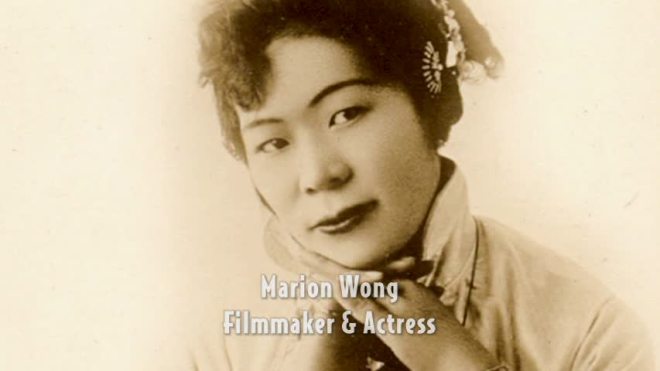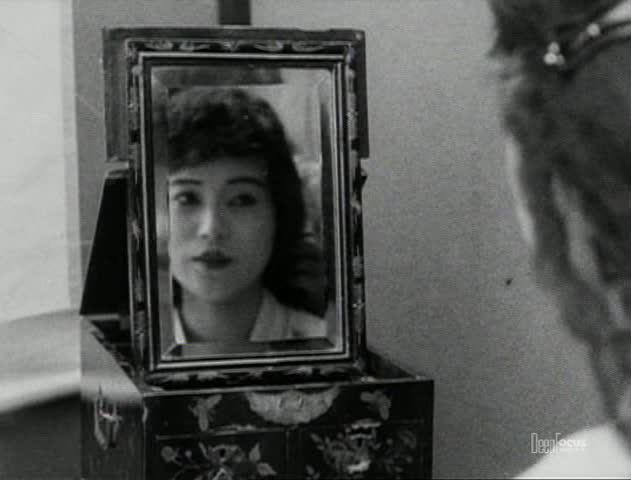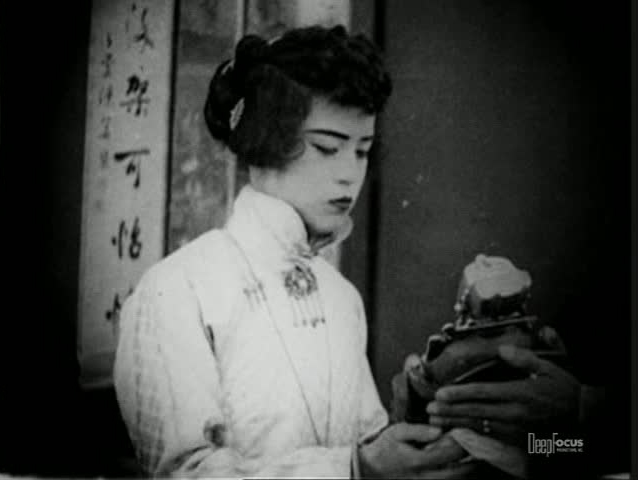The earliest surviving Chinese-American feature film, this picture is also the only known film of director-writer-actress Marion Wong, the driving force behind its production. It’s the story of a young westernized Chinese couple and their difficulties with their more traditional family. Fascinating stuff!
Where there’s a will…
Like many youths in the 1910s, Marion Wong was interested in the movies. Plenty of young ladies had gone to try their hand at acting in New York and Hollywood and some women managed to find work writing scenarios for silent films. Universal was even giving a number of women the chance to be directors. Wong did them one better: she founded her own studio, secured financing from family and wrote, directed and performed in her very own motion picture. What were you doing at twenty-one?
The Curse of Quon Gwon never found a distributor and was almost completely forgotten when it was rediscovered during the research phase of Arthur Dong’s documentary Hollywood Chinese. Alas, the film is incomplete and as distribution copies were not made, it is likely that this footage is all that survives. The film is also missing its intertitles. While the visual nature of silent film acting makes it possible to follow the action to some extent, certain behaviors and character motivations remain obscure. I will be taking the film’s fragmented status and the relative lack of background information into account as I review it.
I should also note that when I review films, I try to be as fair as possible and consider how a movie compares to films of similar budgets. The Curse of Quon Gwon is not from a major studio and independent films of the silent era could be hit or miss. I am happy to report, though, that this is one of the hits.
The Curse of Quon Gwon tells the story of a Chinese-American couple who run into a culture clash with their far more traditional family. Violet Wong, Marion Wong’s sister-in-law and dear friend, plays the very American bride (most of the cast was comprised of Wong’s relatives) who must adopt the old ways to please her husband’s family. Marion Wong plays one of the husband’s family members (the exact nature of their relationship is obscured by the lack of title cards) and she sets about scheming against Violet. The film shows the trials and tribulations of Violet before Marion’s machinations are uncovered and she stabs herself, the actual bloodletting hidden by a tasteful fadeout.

Marion Wong stated that her goal in making the film was to introduce Chinese culture to westerners and she does succeed, for the most part. By making the main couple Chinese-American, she is able to contrast their far more casual demeanor and fashion with the ways of the mainland and provide a surrogate for non-Chinese audiences. Violet and her husband giggle over the traditional wedding garb and she agrees to pin up her Pickford-esque curls but keeps her poofy bangs rather than brush them back. A girl can only be expected to go so far!

Wong also taps into a more universal plot: trouble with the in-laws. While the specific customs may be different, newly married people the world over have had to deal with similar problems. Unlike Hollywood films of the time that featured Chinese characters as mysterious, inscrutable, exotic, you-name-the-stereotype, Wong’s characters are just everyday people trying to make their marriage work and please their family.
However, efforts to be agreeable have their limits. About halfway through the surviving footage, Violet Wong’s character is given a knife and encouraged to kill herself (her crime is not clear due to the missing title cards). She considers it for a moment but then she throws the knife away and storms off. This ain’t no Madame Butterfly, folks!
Violet Wong makes an appealing and likable heroine in the 1910s mode. She’s cute, a little mischievous and has a ready sense of humor. It’s pretty impressive to consider that this was her first and only screen appearance.
Marion Wong is even more impressive. Her icy villainess does well enough but her direction really wins the day. While the sets are clearly outdoors (the wind rustles the tablecloths), this would not be terribly unusual in an independent and lower-budget 1916 production. In the plus column, the scenes are brightly lit, the editing is comparatively slick and Wong’s camera is mobile. In general, production has a snap and polish that is unusual to find in independent films of the day.

Keep in mind that these were still early days for the American silent feature. While feature films were common by 1914, it took a few years for the new length and new techniques to catch on with all directors, especially the ones who had been making films the old way for over a decade. While 1914-1918 showed a lot of innovation and imagination from some directors, there were others who were quite content to nail their camera to the floor and crank away. With this film, Wong showed that she had a clear understanding of tracking shots and closeups. That’s more than could be said for some studio directors.

Regarding the polish of this film: how did a woman living hundreds of miles from the movie capital acquire the skills that Marion Wong displays? There’s a rumor that Wong hired a cameraman from Charlie Chaplin’s crew but I can find no supporting evidence and it does seem odd that this person is never named. While the polish on Wong’s film indicates she might have had outside help, her technique is not so drastic as to make a solo accomplishment unthinkable.
An intelligent and ambitious woman who was also an avid moviegoer could conceivably have picked up the basics on the cinema screen. Further, movie fan magazines regularly featured articles on the technical aspects of film and advertisements for correspondence and in-person filmmaking courses, which included photography. (I collect filmmaking correspondence courses from the silent era and I can confirm that they extremely technical information.) Self-education may go far in explaining Wong’s confidence as there would have been no Hollywood types telling her that her dreams were impossible.

There’s this notion that silent era audience were just awed by what was on the screen and sat there in slack-jawed wonderment. Nope! The content of fan magazines proves that moviegoers took a keen interest in the technical hows of cinema, just as modern moviegoers enjoy seeing how CGI worlds are created or how an impressive stunt was accomplished.
Film critics who are unfamiliar with silent films have an annoying habit of declaring things to be “typical” of a particular silent film period when certainly were not. For example, the overdone acting of The Copper Beeches is written off as “typical” for 1912 when it is actually cartoonishly hammy compared to other releases of the same year. So, I was a little suspicious when I read other critics stating that the direction and performances in The Curse of Quon Gwon compared favorably to other films of 1916. Well, this time the critics are right.
Violet Wong is still a little raw, which is to be expected from an inexperienced performer in her first starring role, but she definitely shows a talent for pantomime. Marion Wong’s direction is similarly rough around the edges but it shows exciting potential.
Let’s just say that if I had been an executive circa 1916 and someone sent me The Curse of Quon Gwon as an audition, I would have hired everyone on the spot. Wong’s work is not impressive because she is a woman or a Chinese-American. It’s impressive work for any first-time director. Period. (For comparison, check out Cecil B. DeMille’s debut film, The Squaw Man, which was made in 1914.)
In what can only be described as a great loss to American motion pictures, Marion and Violet both ended up as restaurateurs. Considering the quality of their only film, it’s intriguing to imagine what they could have done if they had been allowed to hone their craft. Marion Wong had the intelligence, imagination and ambition to become a great Hollywood director. Unfortunately, she was decades ahead of her time.
The Curse of Quon Gwon is a must-see for anyone interested in Asian-American cinema, pioneering women of the silent era, the history of independent film or film preservation. Even in its unfinished state, the movie has much to recommend it and as a piece of history it is invaluable.
Movies Silently’s Score: ★★★
Where can I see it?
The Curse of Quon Gwon is available on DVD as an extra for the Hollywood Chinese documentary. It is accompanied by a suitable piano score.








What a wonderful discovery! You said you were going obscure on the filmmakers/actors and you weren’t kidding! This film absolutely deserves to be noticed, even if it had to wait until 2016 for review. Judging from the stills posted it’s something not just unique because of Wong’s story but because of its obvious quality. Very precious, very special, worth preservation and acknowledgment (and worth hunting for in case more of it has survived).
I’m glad I did not disappoint! Yes, I went into this wondering if the praise for its quality was based on its importance rather than what was actually on film but I was very pleasantly surprised. An excellent production all around.
Wow, this looks fantastic. A shame that even in 2016 Asian-Americans continue to be underrepresented in American film. This looks neat. The women who worked behind the cameras are erased by lazy people who claim no one directed until Ida Lupino. What bunk! How is the documentary the film is paired with?
Yeah, the female directors of the silent era are constantly given the boot from historical texts. A super shame. The documentary is good. It has interviews with Chinese and Chinese-American directors and actors, as well as Anglo performers who took on yellowface roles (Christopher Lee, Luise Rainer) and it covers films from the very beginning (like, Edison-era) to the 2000s. It looks into the whys of casting decisions, etc.
In case any here have not already viewed this:
Some friends currently living in Stinson Beach sent me a local news report:
Couple of gaffs in the tv news feature (one honker is the tired trope that few women were making films at this time), but the footage of Quon Gwon is a treat.
Can we state again our admiration of this site…think we can 🙂
Thanks for the link! Yeah, the women behind the scenes in silent film have been torn right out of the history books, which is a shame. As we can see in the advertisement I included in the review, some of the classes specifically state that they are open to men AND women.
Heavens, you’ve reminded me of the unacknowledged inventor of the sound film, New Zealander Colin McKenzie, as depicted in Costa Botes’ and Peter Jackson’s spoof, “Forgotten Silver.”
Unfortunately the dialogue was in Chinese and McKenzie hadn’t figured out sub titling so the film bombed.
Ha! I was reminded of it as well. That’s what makes Forgotten Silver so hilarious to movie buffs: it’s just close enough to the truth to sound plausible. My favorite bit is the section about color film and McKenzie’s trial. “After repeated viewings of the footage…”
One of the young Maori women playing a South Seas belle in the ‘color’ scene worked for the studio where we recorded the narration. She was fearful of her strict mother’s reaction after seeing herself shown even so fleetingly en dishabille.
Hope she didn’t get into too much trouble 🙂